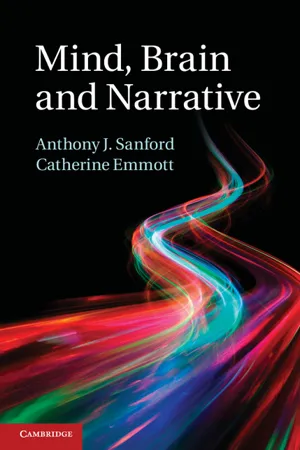
- English
- PDF
- Available on iOS & Android
Mind, Brain and Narrative
About this book
Narratives enable readers to vividly experience fictional and non-fictional contexts. Writers use a variety of language features to control these experiences: they direct readers in how to construct contexts, how to draw inferences and how to identify the key parts of a story. Writers can skilfully convey physical sensations, prompt emotional states, effect moral responses and even alter the readers' attitudes. Mind, Brain and Narrative examines the psychological and neuroscientific evidence for the mechanisms which underlie narrative comprehension. The authors explore the scientific developments which demonstrate the importance of attention, counterfactuals, depth of processing, perspective and embodiment in these processes. In so doing, this timely, interdisciplinary work provides an integrated account of the research which links psychological mechanisms of language comprehension to humanities work on narrative and style.
Frequently asked questions
- Essential is ideal for learners and professionals who enjoy exploring a wide range of subjects. Access the Essential Library with 800,000+ trusted titles and best-sellers across business, personal growth, and the humanities. Includes unlimited reading time and Standard Read Aloud voice.
- Complete: Perfect for advanced learners and researchers needing full, unrestricted access. Unlock 1.4M+ books across hundreds of subjects, including academic and specialized titles. The Complete Plan also includes advanced features like Premium Read Aloud and Research Assistant.
Please note we cannot support devices running on iOS 13 and Android 7 or earlier. Learn more about using the app.
Information
Table of contents
- Contents
- Figures
- Tables
- Preface
- Acknowledgements
- 1 Narrative and the Rhetorical Processing Framework
- 2 Fundamentals of text processing
- 3 Multiple levels: counterfactual worlds and figurative language
- 4 Attention in text: foregrounding and rhetorical focussing
- 5 Rhetorical focussing and depth of processing
- 6 The experiential aspect: using embodiment theory
- 7 Narrative perspective and the representation of speech and thought
- 8 Hot cognition: emotion, empathy and suspense
- 9 Narrative´s social impact: persuasion and attitude change
- 10: Final comments
- Appendix 1 Electroencephalography (EEG)
- Appendix 2 Functional Magnetic Resonance Imaging (fMRI)
- References
- Author index
- Subject index